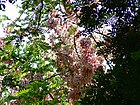Note: This is a project under development. The articles on this wiki are just being initiated and broadly incomplete. You can Help creating new pages.
Senna tora - Chakramarda
Senna tora (originally described by Linné as Cassia tora) is a legume in the subfamily Caesalpinioideae. Its name has been derived from Sinhala language, in which it is called Tora. In Sri Lanka it is easily found in many places. It is often confused with Chinese senna or sicklepod, Senna obtusifolia. If it is given a distinct common name at all, it is called sickle wild sensitive-plant or sickle senna.
Contents
Uses
indigestion, stomach pain, skin diseases, constipation, oedema, Blotches, glaucoma, nyctalopia, leucoderma.
Parts Used
Chemical Composition
The oils obtained were analyzed by GC/MS. They consisted almost exclusively of sesquiterpenes. β-Caryophyllene, germacrene D and spathulenol were the compounds found more frequently and in relatively high proportions in some species [1]
Common names
| Language | Common name |
|---|---|
| Kannada | Sogata |
| Hindi | Panwar, Chakunda |
| Malayalam | Sakramardakam |
| Tamil | Senavu |
| Telugu | |
| Marathi | NA |
| Gujarathi | NA |
| Punjabi | NA |
| Kashmiri | NA |
| Sanskrit | |
| English | Stinking Cassia, Chinese senna |
Habit
Identification
Leaf
| Kind | Shape | Feature |
|---|---|---|
| Simple | alternate | Unifoliolate, 3-foliolate, pari- or imparipinnate or bipinnately compound, then pinnae with one to numerous pairs of leaflets |
Flower
| Type | Size | Color and composition | Stamen | More information |
|---|---|---|---|---|
| Unisexual | 2-4cm long | Yellow | 9 or 10 | Flowers usually bilaterally symmetrical, usually actinomorphic in subfamily Mimosoideae, and sometimes actinomorphic in Caesalpinioideae and Papilionoideae, usually hermaphrodite, rarely unisexual |
Fruit
| Type | Size | Mass | Appearance | Seeds | More information |
|---|---|---|---|---|---|
| dehiscent | 7–10 mm (0.28–0.4 in.) long pome | clearly grooved lengthwise, Lowest hooked hairs aligned towards crown | With hooked hairs | many | {{{6}}} |
Other features
List of Ayurvedic medicine in which the herb is used
- Vishatinduka Taila as root juice extract
Where to get the saplings
Mode of Propagation
How to plant/cultivate
Peacock flower is very easy to grow in alkaline to acidic, well-drained soils[3]
Commonly seen growing in areas
Tropics, weed in many places, South Asia.
Photo Gallery
References
External Links
- Pages that are stubs
- Ayurvedic Herbs known to be helpful to treat indigestion
- Ayurvedic Herbs known to be helpful to treat stomach pain
- Ayurvedic Herbs known to be helpful to treat skin diseases
- Ayurvedic Herbs known to be helpful to treat constipation
- Ayurvedic Herbs known to be helpful to treat oedema
- Ayurvedic Herbs known to be helpful to treat Blotches
- Ayurvedic Herbs known to be helpful to treat glaucoma
- Ayurvedic Herbs known to be helpful to treat nyctalopia
- Ayurvedic Herbs known to be helpful to treat leucoderma
- Herbs with Leaves used in medicine
- Herbs with common name in Kannada
- Herbs with common name in Hindi
- Herbs with common name in Malayalam
- Herbs with common name in Tamil
- Herbs with common name in English
- Habit - Tree
- Habit - Shrub
- Index of Plants which can be propagated by Seeds
- Index of Plants which can be propagated by Cuttings
- Herbs that are commonly seen in the region of Tropics
- Herbs that are commonly seen in the region of weed in many places
- Herbs that are commonly seen in the region of South Asia
- Herbs






